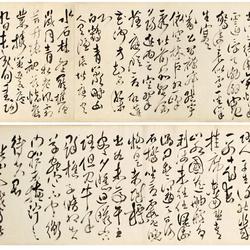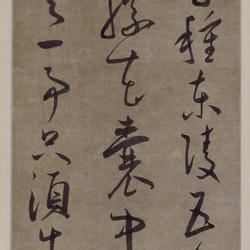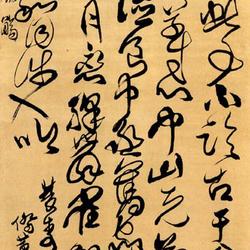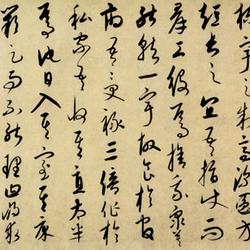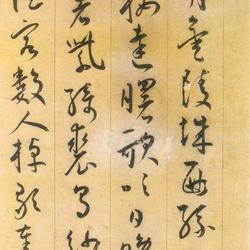Zhao Gou (1107-1187), Emperor Gaozong of the Song Dynasty, was a calligrapher. The son of Zhao Ji, Huizong of Song Dynasty, he was good at Gongzheng, Xing and Cursive calligraphy. When I was young, I liked to stir up my pen and write words. The calligraphy is elegant and honest, and the handwriting is handsome, which is attributed to Zhiyong. I also tried to study Huang Tingjian's calligraphy deeply in this dynasty, and I can quite understand its essence. Bai said: From the Wei Dynasty to the Six Dynasties, all writing methods were copied, and all the styles were prepared in the pen, but there were still choices in the meaning. If you stick to it, you will be able to test it more deeply, and draw it more rigorously, until it can be recited. Tao Zongyi of the Ming Dynasty said in "History of Calligraphy": "Gaozong was good at true, practical and cursive calligraphy. God allowed him to do everything he could to create wonderful things." "Zi Wen" and "Guangming Tower Stele" etc. The biographies "Inscriptions of Gu Kai's Daughter Shi Zhenpu" and "Zan of Chu Suiliang and Ni Kuan" are also said to have been written by Gou. Zhao Gou's "Luo Shen Fu in Cursive Script" is on silk, with a length of 27.3 cm and a width of 277.8 cm. It is now in the Liaoning Provincial Museum.
Zhao Gou's political mediocrity has long been determined by history, but he still occupies a place in the history of calligraphy. In the history of calligraphy, father and son are often called father-son calligraphers. In the past, there were Xi Xian and his son, Ouyang and his son, and Mi's father and his son. In fact, Zhao Ji and Zhao Gou can also be called father and son famous calligraphers.
Zhao Gou said at the beginning of his "Han Mo Zhi": "Since the Wei and Jin Dynasties to the Six Dynasties, I have copied all my writing methods." He also said: "Since I have tied my hair, I like to use the pen to write calligraphy. Although I have often changed my style, I still have it in my heart." What you like is inherent. In the past fifty years, unless there were great interests and dangers, I would not give up writing for a day." In his early years, Zhao Goushu studied Huang Tingjian and Mi Fu, and was greatly influenced by the current trends. After he ascended the throne, he studied Tang Dynasty scholars such as Yu Shinan, Chu Suiliang, and Li Beihai. The influence of the two families of Yu and Chu can be seen in the existing "Yue Fei Chi" and "Preface to the Imperial Collection of Huizong". The golden period of Zhao Gou's calligraphy was after he retired as the Supreme Emperor. According to "Gaozong Ji", Volume 32 of "History of the Song Dynasty", "In the 32nd year of Shaoxing, the crown prince was appointed emperor, and the emperor was called the Supreme Emperor. He retired to Deokshou Palace... Chun In the 14th year of Xi's reign, in the tenth month of Yihai, he died in the Deshou Hall at the age of eighty-one." In the 32nd year of Shaoxing, Zhao Gou was 55 years old, which was considered a prime time. He was freed from the dangerous situation and complicated government affairs. In the next 26 years, he spent enough time and energy to improve his calligraphy to the highest level. A new level. During this period of time, he devoted himself to the Six Dynasties, "Every time he got a right army, a few lines, or a number, he would not put his hand aside" ("Han Mo Zhi"). After many changes of models, he finally determined his own identity. Tao Zongyi of the Ming Dynasty said in "History of Calligraphy" that "Gaozong Shanzhen's cursive scripts are all wonderful. Perhaps Yun Chu learned Mi Fu, and supplemented them with the style of the Six Dynasties, and became his own family." "Cursive Script "Luo Shen Fu"" is his masterpiece in his later years.
"Luo Shen Fu" is a famous work by Cao Zhi. He has used calligraphy and painting in the past dynasties to produce many excellent works. As far as calligraphy is concerned, there are Wang Xianzhi's regular script, Zhao Gou's cursive script, Zhao Mengqi's running script, and Zhu Yunming's cursive script. They are all masterpieces in the history of calligraphy.
Zhao Gou's cursive "Luo Shen Fu" is now in the Liaoning Provincial Museum. It is on silk and is 27.3 cm high and 277.8 cm long. It is signed in Deshou Palace and is indeed a work in his later years. When writing, all the modal particles "xi" in the original text were omitted. Such omissions are rare in calligraphy works. The calligraphy of this work is skillful, the writing style is mellow, and it is written in one go. It is smooth and thick, flying and calm. It can be seen that the calligrapher was full of energy and had a clear interest at the time. It was written in his later years rather than in his decline. The work belongs to Xiaocao. Although the spirit and veins are coherent, the words are independent and clear. Zhao Gou once said, "Most of the predecessors were able to write in straight script and then in cursive script. It is indispensable to use both methods... The grass can fly like a dragon or a phoenix, and it can speed up the writing power, excel in heroic deeds, and never distort the truth." "A scholar must first learn calligraphy." For those who write the regular script, all eight methods are used, and they are not attached to each other. As for the characters, they can also be read correctly, staying true to the original body, and covering the remaining style of the official script. If the regular script method is achieved, then the brushstrokes will be written freely in the grass, and the two methods will naturally reach the perfection and shine. The wonderful body of the hand has no clues. On the contrary, it will flow into the world, and those who are not aware of it will just point to the eyes." Emphasizing the basic role of regular script, he advocated that cursive script "makes the strokes undistorted as a priority", so his writing is free from the habit of being continuous and simple, and is easy to identify. In fact, as early as Su Shi, he often emphasized the importance of regular script and advocated that there should be rules for running cursive script. The so-called "True begets walking, walking begets grass. True is like standing, walking is like walking, and grass is like walking. There is no one who cannot stand but can walk." (Su Shi Huang Tingjian also said in "The Calligraphers of the Six Families of the Tang Family" that "the calligraphy of the Tang Dynasty wanted to follow the rules of the left and right, which was the beauty of the ancients" ("On Calligraphy"). This should be a temporary concept of calligraphy. The people of the Song Dynasty still believed that "it should be taken as a whole, based on the premise that regular script and running script are the representatives of the calligraphy arts of the Tang and Song dynasties respectively." If one specializes in cursive writing, people in the Song Dynasty also respect the law. The admiration for law even restricted the further development of cursive script in the Song Dynasty.
Although this volume by Zhao Gou is of his own family, it also has its own origins. Among them, Zhiyong's influence on him is more obvious, which can be seen in the meaning of his brushwork and the momentum of his calligraphy. There are still some shadows of Mi Fu. "Han Mo Zhi" once specifically mentioned Zhiyong and said that he "had his collection of Qianwen". There is also "Lin Zhiyong Zhencao Qianziwen" in Zhao Gou's handwriting today, which shows the depth of his immersion. "Han Mo Zhi" made no secret of his love for Mi Fu, and even recorded some details of Mi Fu's life, which is very similar to today's star-chasers. Mi Fu slandered the previous sages in "Haiyue Quotes", and was inferior to the two kings. , only Zhiyong's "Thousand Character Essay" promised to be "beautiful, round and vigorous, with all aspects". Zhao Gou's love for Zhiyong may have been influenced by Mi Fu. In addition, if we compare Mi Fu's "Incense-burning Tie" with Zhao Gou's "Luo Shen Fu", we can also clearly see the similarity between the two. It can be said that the early use of Mi Fu is still involuntary in Zhao Gou's later works. outpouring.
Lu You once said, "Si Ling (Zhao Gou was buried in Yong Siling after his death) mastered the Eight Dharma, paid attention to ancient elegance, visited Dharma books and famous paintings, and spared no effort. In his leisure time, he spent a lot of time playing, playing, and copying." Zhao Gou claimed that " In the past forty years, every time he wrote calligraphy, he wanted to encourage scholars, which led to the prosperity of the generation. If someone promoted it, it would become popular. In the Southern Song Dynasty, with Zhao Gou as the center, there was a strong trend of learning calligraphy, which was enough to "revitalize" the small court. " embellishment, Zhao Gou has his own contribution to the development of calligraphy, and there is no need to erase it. Of course, the greater his contribution, the more he failed the country and the country at that time - calligraphy was really a good medicine for him to avoid responsibilities and use it to comfort himself.

